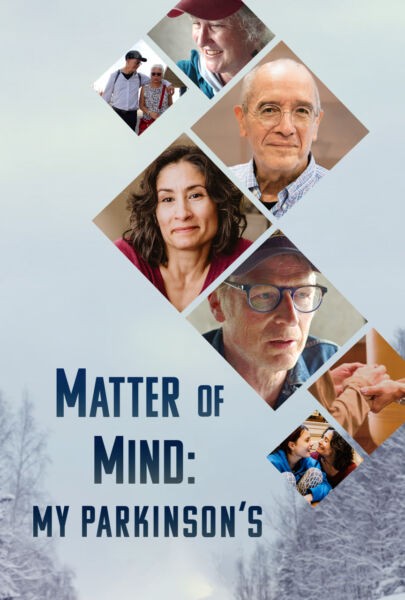By Veronica Garcia-Hayes with Craig Phillips
San Franciscan Veronica Garcia-Hayes, featured in the documentary Matter of Mind: My Parkinson’s, was diagnosed with early-onset Parkinson’s Disease (PD) when she was only 39, and pregnant. But Veronica was determined not to let the disease stop her active lifestyle and wanted to share her love of fitness with others, which is why, in 2017, she became a certified boxing coach specifically for people with Parkinson’s. While managing progressing symptoms alongside co-parenting a now-teenage daughter, she’s become a staunch advocate for exercise for people with PD. Multiple studies have shown that exercise is one of the most powerful methods of slowing the progression of this neurodegenerative disease [sources: NIH: National Library of Medicine; Johns Hopkins Medicine; Parkinson’s Foundation].
Veronica updated us: “[Since the documentary was filmed] my life has completely changed. Last year at this time I could barely walk, and now I feel like I have almost full ability because I had Deep Brain Stimulation surgery a year ago. Getting back into the swing of things has been difficult for me because I was down for so long and I got into my own rut.”
Here she gives us advice for others with Parkinson’s on keeping physically fit, plus she gives us her own routine, talks about how staying connected is integral for people with PD, and suggests activities for all ages that can help symptoms.
Recently diagnosed with Parkinson’s? Here are some of Veronica’s starter tips and recommendations about physical exercise
Veronica: I work with so many people newly diagnosed, and others who have been in it for a long time in various levels of fitness. The number one thing I emphasize is pick something you like, that you’re actually going to do. It’s like a New Year’s resolution. We all shoot for the stars and never follow through. Start small, something you like and are going to do, that’s number one.
Secondly: Find a friend you would commit to, a workout buddy. Make an appointment with someone else so they hold you accountable and vice versa. It’s almost like making an appointment with your doctor. You wouldn’t cancel and wake up that morning and say, “I really don’t want to see my doctor today. I’m just going to blow it off.” For me and those who struggle with scheduling and always wanting to do something above and beyond for other people: Make the appointment and stick to it.
“People generally can do a lot more than they think they can.”
Most common misconceptions from clients or peers with Parkinson’s
Most people that come to me have some fitness background, and those that don’t are pretty intrigued about the boxing program I work with. [Her affiliate at HitFit gym] Rock Steady Boxing is a non-contact boxing training regiment that challenges gait, balance, memory, defense, offense, multitasking. It runs the gamut. I let people know that, although our classes run anywhere from 75 to 90 minutes—which makes them go, “Oh my God, I’m going to have a heart attack if I do 90 minutes of exercise”—it’s not 90 minutes of intensive exercise per se. We do a lot of voice activation and getting-to-know-you conversation.
[For example] People with Parkinson’s tend to lose the power of their voice, so we practice projecting over the noise of the gym. When people are expected to talk in public, in front of a class, the tremor starts to come out because the stress of that situation manifests itself in a physical way. People just think of boxing, “I’m going to be hit in the head, hit in the face.” That’s the misconception, we are a non-contact boxing program. We incorporate all kinds of different exercises, whether it’s circuit training, cardiovascular, cognitive games, or memory games. Everything. People generally can do a lot more than they think they can.
Veronica Garcia-Hayes and her daughter
We have orange balls covered with letters of the alphabet and numbers 1 through 12. We work in partners, or groups of three, tossing the ball back and forth. This is something you could do at home against the wall of your own house, or if you have a kid or your grandkid that’s with you and they could toss it—make it fun for them and you. When you throw the ball and catch it, whatever your eye tracks and whatever letter comes up, you just call the letter out, back and forth. Or call the number out to take it up to the next level. You get the letter A, you say a word that begins with that letter.
You’d really be surprised that a lot of our volunteers, people who help out in the gym, that don’t have Parkinson’s, really struggle with this type of game, but it’s memory, it’s coordination, and it’s being able to project your voice over everyone else.
Related
A Cartoonist Talks About How to Be an Artist with Parkinson’s
Try to find virtual classes
Look through the Parkinson’s Foundation. There’s a Parkinson’s Alliance, there’s PD Connect, and [the Bay Area-based] PD Active. There are many resources online where you can find virtual classes for people with Parkinson’s. Most of the time they’re free, and if they’re not, it’s a nominal fee to participate in activities like dance, ballet for people with Parkinson’s, singing, boxing, TRX [Total Resistance Exercises]. You could find lots of resources online.
My boxing classes were always in person offering various levels [with] a couple of classes for those with more ability than others. But since the pandemic, we had to—that favorite word of everyone’s—pivot and figure out how to keep things afloat. We went from in-person to virtual, and then as we started to come back, we eked into the gym again. We have a lot of people who just don’t want to come back into the gym, who’ve had maybe some decline over the past few years, who physically can’t get to the gym. So we now offer classes both virtually and in-person.
Recommended starter routine for people with Parkinson’s: Walk, stretch, yoga
Start with walking. Over time, people with Parkinson’s—when they walk—don’t swing their arms any longer. That tends to affect our gait and our balance, which translates into more potential to fall. So number one would be walking consciously, slowing yourself down. I actually count in my head when I’m going up and down stairs to slow myself down because my brain wants to go faster than my feet can, and generally speaking, if I don’t slow it down, I will fall or trip.
I recruit my daughter to walk with me. I do one in the morning. I also walk in the evening probably before I have dinner. And I managed to get her to come along with that. The other night something came up and I wasn’t going to do the walk. She said, “Mom, we’re not going to do the walk?” She’s come to expect it, and it becomes part of that routine. It takes about 30 days to make something a habit, so if you can—even if it’s a 20-minute walk—forcing yourself to get out the door each day for 30 days, then eventually you don’t even think about it. It just is.
“Find a friend you would commit to, a workout buddy. Make an appointment with someone else so they hold you accountable and vice versa.”
Pace yourself, walking consciously, swinging your arms, stretching. We all tend to get a little tight. People with Parkinson’s tend to curl up into themselves and we’re no longer open and wide. And so there’s a lot of tension on the muscles if you’re constantly hunched over your legs and your back is constantly pulling back to keep you from falling forward.
That’s a constant interaction between the brain and the muscles. So stretching is super important.
Yoga if you can, and meditation. It’s basic stuff. It doesn’t have to be hardcore. There are some people who really need that in their lives, but my advice to get started is calming the nervous system down, taking our time, being thoughtful in meditation.
As far as the heavier athletic stuff, again, it just goes back to what you are used to, what you are comfortable with. And if you need to find a professional, find a personal trainer that can at least help you get started in putting something together, a routine that you will stick with.
Veronica’s daily exercise routine
I’m trying to get back on track, but I generally start my day with a walk by myself, weather permitting, to clear my head. For at least an hour. Get the blood flowing, I get into my own head space, and meditate a little bit at the top of the park near me.
If I’m teaching a class, it’s exercise because I’m hitting mitts with everyone. I’m walking backwards as I’m doing it, I’m challenging myself.
For clients I see one-on-one, I know them enough that we can work out together. It could be anything from running lines—running to the end of the court and then run back, and then three-quarters of the way and run back halfway—to TRX for strength, weights for strength training. At one point, I was also seeing a personal trainer, because again, it’s easier to have someone tell you what to do than it is to get motivated yourself. For me, it’s all about strength.
My routine at home could be pushups on the wall, planks on the floor, or a wall sit where I’m challenging my quads, anything that I can do within the moment with not a lot of equipment. You don’t have to be in a gym to work out.
Since my surgery, because I have a battery pack in my chest, I’m still kind of healing. I can’t do a full pushup on the floor anymore. So adapt exercises for yourself. You could do a plank on a wall [instead of] on the floor, you can do a pushup on a wall or, if you have a set of stairs—obviously the lower you get, the more difficult it’s going to be. The higher you are, the less stress you put on yourself.

Activities that slow Parkinson’s roll
It’s hard for me to quantify because I feel like I’m in constant movement. I have a 14-year-old daughter and running around with her is exercise in itself. And that’s the difference between young onset and people who are diagnosed later in life. It really just depends on where you’re at activity-wise. Older people have different challenges. Swimming is great. It’s coordination for the body, easy on the joints.
There are studies that indicate pickleball, then ping pong, and tennis actually slow the progression of Parkinson’s. Tennis being third best, because you think about how long it takes you to react to a tennis ball, it’s a little bit slower. Pickleball is faster, ping pong is even faster than that. The reaction times and the eye-hand coordination really slows down the progression.
Force-intensive exercise gets the cardiovascular system up at a minimum of 70% where you work to a point where you’re winded, but can have a conversation. It takes a bit of effort to get those words out, but that’s how you test yourself without doing any sort of calculations. “Can I talk? I’m talking too easily. I’m not working out hard enough.” Cardiovascular is known to slow the progression of the disease.
For bone health in general, weight training is really good for increasing bone density. As we get older, our bones get weaker, and if we’re falling more, we are more likely to sustain an injury that will prevent us from getting that workout in.
Staying connected >>>> Isolation
For people who don’t have family or friends nearby, trying to stay connected to the community [is important]. Beyond physical exercise, finding someone or someplace where you have camaraderie is crucial. Join a support group, or find people within your community that have Parkinson’s and you create your own group. I used to go to a support group through UCSF and it was fairly large and established—there were a lot of people. When you’re in a larger support group it can be hard to weed through to connect.
A few of us ladies from the USCF group branched off and started our own. We meet for coffee or cocktails and conversation. Find people to stay connected to, because fatigue is real, apathy is real, depression and anxiety are real, and if you don’t stay connected to people, it just gets worse. The progression continues, I feel, at a much faster rate than if you are with people.
There are times in the morning I wake up and I’m tired, I have my own stuff I need to work through, and I’m like, “Ugh, I have to teach class today. I don’t even really want to leave the house.” [But] by the time I get there I’m like, “This is great.” Excited and happy to be there. And I feel wonderful for the rest of the day.
Stretching routines
It’s more of a floor routine. I follow some of my experience in yoga just from years of doing it. But if you’re older or you’re not a very active person to begin with, find a stretch routine that you could do from a chair. You don’t have to be completely on the floor. There are things that you can adjust.
When I have a class, it’s all levels, people with full ability as well as people in wheelchairs, or they may require assistance to get from point A to point B. And what we do is everyone is expected to be their own advocate, but we also make adjustments for them. So I would demonstrate a floor stretch from the floor, but then I would also show how to do it from a seated position. I find videos online that are purely stretching videos for people who have Parkinson’s.
Everyone is unique; be kind to yourself
What I try to do is start within my ability that day and I never compare myself to anyone else—including myself. I don’t compare myself to what I was able to do a week ago or last night or an hour ago, because the ebb and flow of the intensity of the symptoms changes daily, it’s a moving target. Be kind to yourself! Some days you’ll be able to go harder and other days you won’t. That’s just the nature of the beast.
I know people at times get frustrated in my classes and I can see it in their faces. I’m like, “Guys, you just have to be kind to yourself because stress on top of it all is really bad for us. Switch your focus, do something for someone else to pull out of it, and realize that maybe one day you’re going to be helping someone, and another day they’re going to be helping you.”
Recommended resources:
PD Active
PD Connect Exercise Classes
Parkinson’s Foundation
Michael J. Fox Foundation: Run, Walk, Cycle
Related Films






